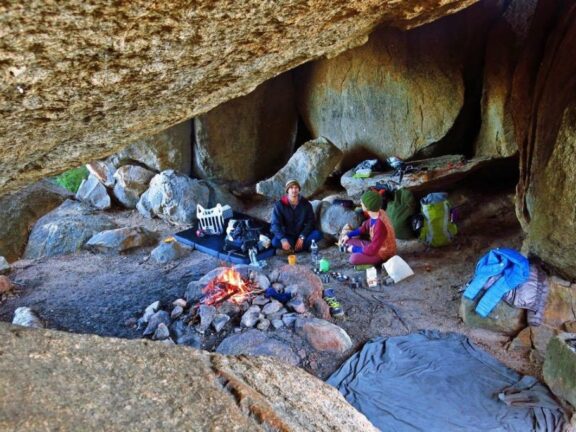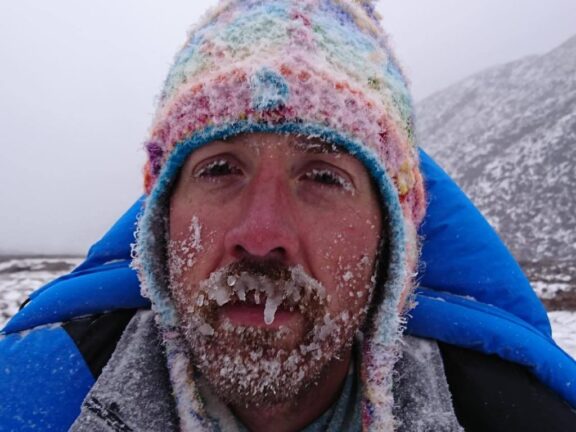Convincing your loved ones to camp





By Tommi.
You know what I mean. All of us who appreciate challenging ourselves in the peaceful solitude and beauty of the great outdoors have people in our lives who we know would fall in love, as we did, with the wilderness – if only they gave it a chance.
But how? How do we set about convincing these dear ones that perhaps there is more to camping than eating, sitting, sleeping, and defecating in the dirt, all whilst struggling to keep warm? There are often many hurdles to overcome in converting a ‘normie’ into an outdoor enthusiast. Here we will use steps adapted from graded exposure therapy, normally used to treat specific phobias such as fear of heights or needles. I hope to lay out a blueprint for effectively turning your best mate from an outdoor sceptic to a route-eating machine that stares into the face of adversity … and winks.
1. Set out your key goal
During graded exposure therapy, it is usually essential to define the patient’s treatment goals. Maybe they’re afraid of dogs but want to find the courage to pat one; perhaps they need to present to a crowd but can’t. But, dear reader, let us be honest: this is about us. So before starting down the pathway of convincing your love ones that camping is pretty bloody great, it is worth taking a moment to consider this: what is your goal? Why is it so important that this friend fall in love with the outdoors?
It may be a simple goal. Perhaps you want your wife and kids to spend a couple of nights in a local national park. Or maybe your intentions are slightly more sinister, involving a lot of rope, some sharp objects, and two one-way tickets to Nepal. To ice climb.
Once you have identified your ultimate goal you can proceed to step 2.
2. Build an exposure step ladder
The next crucial step in graded exposure therapy is determining a series of smaller goals that will help you reach your ultimate goal. This bit is easy, right? Well, it’s more complicated than simply starting with a day walk and progressing to carrying packs and doing overnighters. This is also about accumulating the skills needed for your main goal, and breaking down things such as dislike of the cold and discomfort. You’ll need to be playing chess not checkers here. Your first few goals need to be guaranteed successes, things that are outdoor-adjacent that you know they’ll love. From there, pick one area of the comfort zone to stretch.
3. Gain consent
Okay so in your mind you have it all mapped out before you. You think you’re all over convincing your loved ones to camp at this stage. It starts with a drive out into the hills and a picnic in the botanic gardens on a warm spring day and ends with a 40 day walk into thin air and -30 oC. Maybe you’ve already gained implied consent and completed a few of the easy goals with your ‘patient’. However, at some point we’re going to need to convince your loved one to take a leap of faith, to trust you and your wilderness abilities. This is where things start to get tricky.
4. Deal with past trauma
There is a wide spectrum of humanity, and unfortunately, many have already made up their mind that camping is not for them. Now we could yell and scream, call them bigoted and ignorant, or we could acknowledge, as Freud would, that their disdain for camping likely stems from past trauma. Delving into this trauma is a useful way to break down the barriers of impeding you from having the adventure partner of your dreams.
4a. Revisiting the past
The extent and cause of past trauma can be vast. It is possible that their father used to run spartan expeditions into the wilderness, disguising his sadistic hikes in the driving rain with nothing to eat but tinned smoked mussels as ‘family holidays’. Perhaps their last camping trip was a school camp full of teenage angst and tears, sleeping on a $4 yoga mat. Or maybe they went to a festival in their early twenties and were rudely awoken by someone falling on top of their tent on the first night, destroying the poles and any future interest in the outdoors in one fell swoop.
Getting to the bottom of these past experiences is essential. So listen! It will highlight sensitive areas and things to avoid, but more importantly, it will also, eventually, lead to the question:
‘Why don’t we [insert activity here] at [insert destination here]?’
— A quick aside about timing: it’s best not to ask a reluctant camper of romantic interest this question too early in the relationship. Your best-intentioned attempts to immerse them in the freedom of the wilds may, I must warn you, give off a certain amount of Ted Bundy vibes. Best to wait until the relationship is slightly more mature. —
4b. Heading into the future
At this point you may encounter some resistance. Fear not: because you already know why they dislike the idea, you can readily present your counterpoints:
- ‘You won’t be cold! My sleeping bag is -7oC rated and we will pack extra layers.’
- ‘You will be super comfy! I have Helinox chairs and a super thick but light Nemo air mattress.’
- ‘We will eat really well! I’ll bring wine and cheese, and on Sunday, we can go to the bakery on the way home.’
- ‘I promise that there is no such thing as a drop bear! And yes, I’ll go with you when you need to use the long drop at night.’
In the face of such specifically targeted and well-reasoned debate, your budding wilderness expert will have to concede: ‘perhaps I have never been camping properly’.
This admission is the window required to set your friend free on the winds of whimsy and wonder that is available to them, if only they would let the outside in.
In the next update, we shift our focus to the planning, execution, and slow climb up the exposure ladder to achieve your outdoor goals with a sometimes-reluctant loved one in tow. Convincing your loved ones to camp is within reach with my help.
Until then, my fellows in adventure.